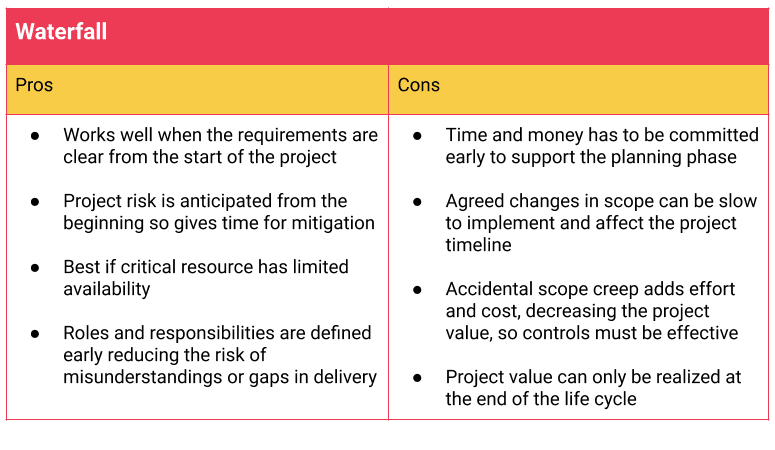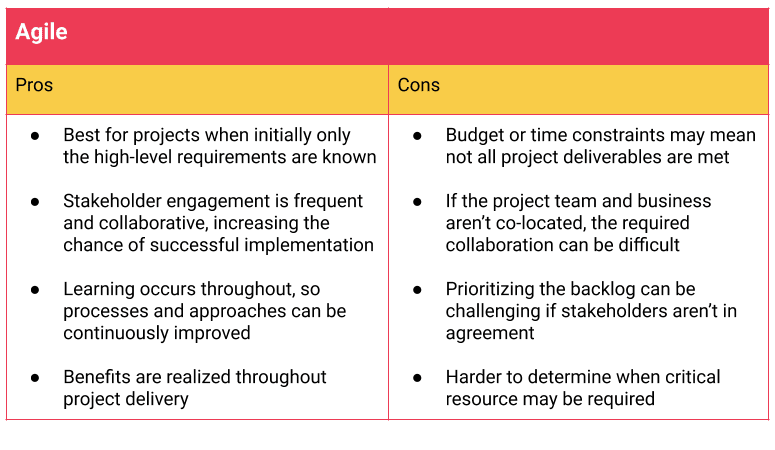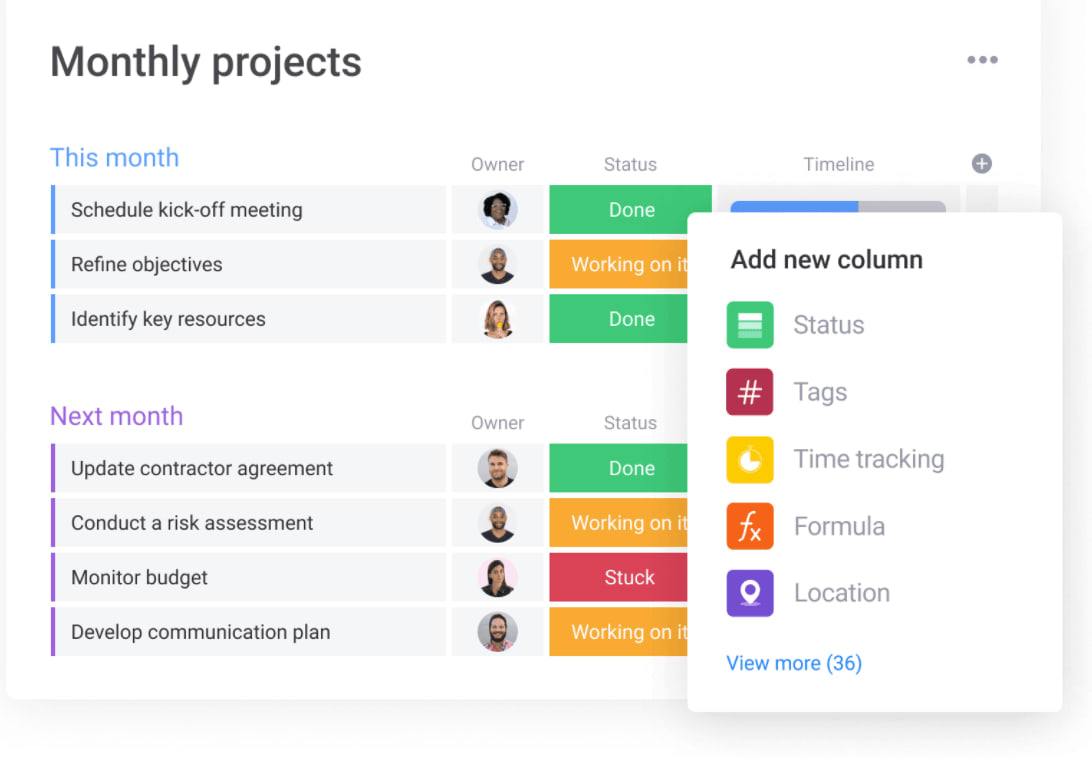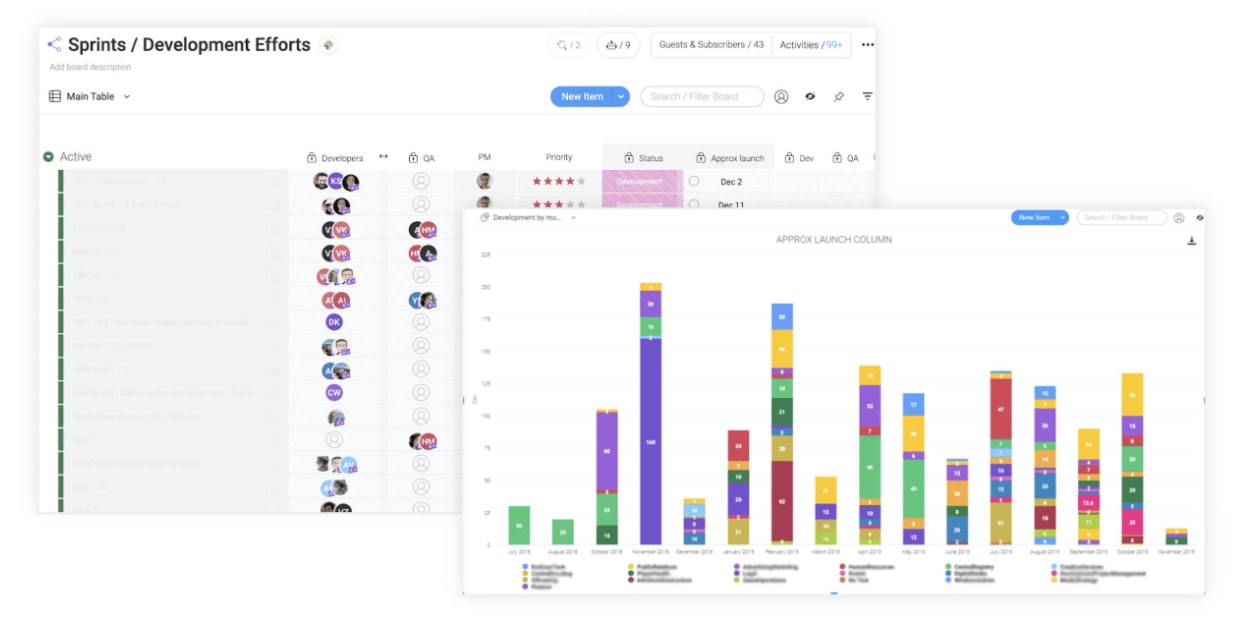We’re all familiar with is project management example. The moment when (eek!), your boss says, “Could you just…[insert incomprehensible but seemingly important task]?”
There is quite a wide range of project management tasks out there, all demanding that you complete the project on time and within budget. An example of an IT project could be creating a system to manage issues tracking, while one for operations could be creating a roster of employee dietary needs against package deliveries from start to finish.
No matter how simple or complex the project, we have it on good authority—and so do groups like the Project Management Institute— that starting with a sample project methodology is a great way to start.
In this article, we’ll cover that, identify the four key factors common to successful project examples, and share some top project management examples you can draw inspiration from.
Here’s a high-level overview of the project management process.
The 4 common phases of a project
First, let’s talk about the phases that a project goes through from initiation to completion. The project lifecycle contains four main phases – initiating, planning, executing and closing. It’s a structured path that helps make sure that the project goes from conception to completion, ensuring that all stakeholders are in the loop and all project objectives are delivered at each phase.
Let’s look at each phase:
1. The initiation phase
This is when you get everyone on board. The project manager needs to define the organization, client, customer’s goals, identify key stakeholders and define the project’s goals. They also need to define the project scope and determine the measurable objectives (SMART goals) for the entire team.
2. The planning phase
Next, map out the project. Define the key elements and numerous tasks involved in the project. Look at the project timeline and decide on who does what. It’s important to create a project plan with a checklist to properly manage the project budget, resources, costs, and timelines. Remember to define deliverables at each key milestone or stage of the project.
Pro tip: the project manager should also account for potential risks and have a really good communication plan ready in case something goes wrong. This is especially critical for complex projects that require multiple teams’ involvement.
3. The execution phase
In this phase, the project manager’s job is to oversee the process, making sure that everyone understands what is required of them, what project tasks need to be done, and that everyone completes those tasks on schedule.
A few things that help during the project execution phase are:
- Use collaboration tools to make sure everyone are on track and working together
- Communicate time frames and goals regularly
- Use the right project management methodology (be it waterfall, lean, agile, or the critical path method or Work Breakdown Structure (WBS)) to execute your project seamlessly
4. The closing phase
At the final stage of the project, the project manager checks that every team completed all of the tasks and project deliverables, presents it to the stakeholders, and gets them to sign off and officially close the project.
Why do the best project management examples start with a methodology?
Identifying a methodology during the project planning phase is both good project management practice, and common sense.
Organizations that invest in good project management practices, waste 21 times less money than those without an effective project management approach.
Methodologies set you up for success by providing the big picture perspective on each part of the project schedule and how the project is going to run.
There are traditionally 2 methodologies used for managing projects and they both have pros and cons:
The Waterfall framework
This example of a project management methodology is a linear, step-by-step approach where each new project phase follows the end of the previous one. It provides a great visual representation to every part of your entire project.
With this methodology, having a robust project plan is vital and lots of work needs to be done upfront to get really clear on the project goal. Examples of project teams who may use this method are those with fixed timelines and budgets, such as aerospace or defense teams.

The Agile framework
The Agile project management method in contrast is a more iterative approach where the project team members and project stakeholders work together to refine the project outcome through feedback and review.
Project activities are delivered through short “sprints” or iterations and a list of what needs to be done next — usually called the “backlog” — is prioritized according to feedback. Project activities are delivered through short “sprints” or iterations and a list of what needs to be done next — usually called the “backlog” — is prioritized according to feedback. IT projects are examples where Agile might be used.

Whichever type of project management or methodology you choose, there are a number of things you can do to increase your chance of a successful project and start earning kudos from your boss.
What are the critical success factors?
The Association for Project Management (APM) says there are 12 conditions for project success. It came as no surprise to us here at monday.com that proven methods and tools were one of the 12. After all, that’s what we’re in the business of. Read on for a list that could make you rethink how you craft project management project ideas.
These 12 conditions fall into 4 main factors:
- Visibility. From the outset, the project’s goals need to be clear to all key stakeholders (and match with business objectives). During the life cycle of the project, it’s important to understand who is working on what and when. A well-defined project management plan reduces confusion and makes sure the workload is evenly spread across the project team.
- Efficiency. To maximize the project’s value you need to minimize waste during the project lifecycle. Whether that’s wasted time, effort, or money, these things need to be monitored and well-controlled to determine project progress.
- Communication. Communication between members of the project team and the wider business is key for successful implementation. Effectively communicating the benefits of the project can improve the chance of its outcome lasting longer than ice cream on a hot day.
- Collaboration. Few projects run independently. Most success in project examples is attributed to collaboration across teams, and with internal or external stakeholders for creating a project and getting the job done.
How can project management tools help?
Ok, you’ve picked a methodology and you’re ready to get started. So why exactly does the APM think tools are so important for project success in any business project example?
Well first of all, you need a place to organize all of your information and to craft a smooth and automated workflow. Check out what one user had to say about monday.com as their project management tool.
monday.com is excellent at planning. Personally, we think it’s the best.
What might surprise you is how intuitive it is to use. And how it integrates with all your other favorite tools. And inspires you more than a gantt chart. Which might be just what’s needed after that stakeholder meeting on a dreary November afternoon.

monday.com makes it easy to monitor the project through its lifecycle, keeping a keen eye out for scope creep with intuitive and customizable templates. Our project management software can also help you out with resource management, time tracking, and managing project risk.
And, what about a more Agile approach? Well, good visibility and communication are key.
Using a project management tool, such as a Kanban board, to help you track what’s been done, is being done, and needs to be completed is important for managing the backlog.

Using a sprint retrospective tool allows you to review the sprint and collect the feedback necessary to decide on the next steps. Without an ability to gather and track this feedback it’s likely that effort will be spent doing the wrong things, decreasing the project’s overall value.
4 great project management examples
To get an inside look at how monday.com is the perfect platform to get your optimized project management workflow up and running, here are four examples from real monday.com customers.
1. The National Hockey League (NHL)
Challenge: Increase visibility
After first loading NHL game stats onto the web over 25 years ago, NHL developers have managed 100s of requests for custom applications. In-house developers now share the workload with a team in Belarus.
Relying on email and text to collaborate over different time zones was causing several challenges including unclear prioritization and ineffective workload management.
Solution: Development roadmap and sprint planning
Using the monday.com platform has brought transparency across the development cycle. Now, at any moment, everyone on the team can see who is working on what, and when.
Using the bar graph view, the business can easily track which units have commissioned the most development cycles across the year. The team also uses the Calendar and Chart app to organize and track fan engagement programs.

While initially focused on improving their sprint planning, the NHL has also begun to exploit other capabilities of the monday.com Work OS. Building workflow apps within the platform has reduced the need for custom development, reducing the development time by 4+ weeks per cycle.
For more on how the NHL increased their visibility and saved 4 weeks per development cycle, check out their case study.
2. Zippo scaling their business globally
Challenge: Improve efficiency while scaling globally
Zippo compiled their product catalog on paper-based worksheets before transferring them to a digital version. The process took around 2 weeks for 20–30 active projects and became outdated almost as soon as it was completed. Zippo knew if they wanted to scale their business their processes needed to become more efficient.
Solution: In integrated Work OS capable of managing internal workflows and external suppliers
Initially signing on 10–15 users with a monday.com Pro account, Zippo now has around 125 users on an Enterprise solution. Building the product catalog has become a collaborative effort with users able to drag-and-drop projects into the catalog and shift things around in real time as priorities change.
Through the dashboard views, stakeholders can track progress across all the projects and monitor the overall workload of the team. This means people can be matched to resource gaps speeding up delivery.
Zippo also set up an automated system for workflow approval. A reminder is sent to the task owner if there is an outstanding request. This makes the approval process faster and increases efficiency.
These changes mean that, over the last 8 months, Zippo could focus on global expansion, acquiring new businesses, and entering new markets.
For more on how Zippo improved their efficiency and saved £82k/year while expanding into new markets, check out their case study.
3. Deezer centralizing business development
Challenge: Enable global collaboration while keeping the ‘local hero’ approach
The music streaming service, Deezer has a team of editors worldwide who understand local music tastes and market towards them. Coordinating this dispersed team from the European HQ was challenging and campaign management was siloed within countries.
Business development was also managed regionally. With no centralized system, it was hard to prioritize support requests to other departments such as finance and legal. This meant new deals took a long time to reach the market.
Solution: An integrated, intuitive workspace that brings multinational collaboration
Deezer used monday.com to build a centralized pipeline of all business development projects which meant work could be analyzed and prioritized globally. This streamlined the work required from the support departments improving time to market speed.
There were also benefits for the customer engagement team. With the monday.com Work OS, campaign planning, management, and evaluation are now visible to teams in all countries.
Being able to see what other teams are doing has led to more brainstorming and sharing of ideas and the number of campaigns per week has increased by 142%.For more on how Deezer improved global collaboration and increased their customer engagement by 483%, check out their case study.
4. The Israeli Government setting up a National COVID-19 Center
Challenge: Ensure effective communication during a global pandemic
As the number of cases grew, Israel set up a National COVID-19 Control Center. The Control Center brought together civilian and military agencies, for the first time, to manage the crisis and support front-line workers. Each agency had its own processes and way of working but a coordinated response was needed immediately if the situation wasn’t to grow out of control.

It was proving incredibly challenging to get accurate testing information from labs and hospitals meaning it was impossible to create a “big picture” perspective of the situation. Essential equipment and suppliers were sourced in an ad-hoc manner and there was no central communication channel to monitor or follow up leads on potential suppliers.
Solution: A centralized, flexible platform with customizable permissions
Communication around procurement is now seamless, with multiple connected workflow apps integrating information on requirements, suppliers, approvals, and financing. These have customized permissions so the right people approve each step at the right time.
It’s also easier for hospitals and labs to communicate with the Control Center. The team worked with monday.com to create web and mobile forms to collect up to date information. These can be submitted at any time and entered into the centralized system immediately.
For more on how monday.com is continuing to support the Israeli government with their COVID-19 response check out their case study.
Be your own project management example
At monday.com we provide you with the features and solutions to help you feel more confident in tackling your next project with more ease and efficiency. What do you want to manage better?
